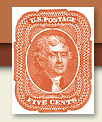|
One of the most elusive of early United States stamps is the imperforate
five cent issued in 1856. Produced from a single plate, it is
estimated that only about 150,000 were sold before being replaced
by the perforated version in 1857. The five cent value was created
in part to serve the need for the five cent open mail rate. Under
the United States-British Postal Treaty, a letter could be sent
to France, or beyond, bearing only five cents postage. This amount
paid the rate to Great Britain. Since the only low value stamps
available from 1851 to 1856 were in denominations of one and three
cents, this open mail rate required at least three stamps.
The five cent imperforate saw very little usage in the domestic
mails. It was used infrequently to pay three cent multiple rates,
or the ten cent rate over 3,000 miles. Only two examples are recorded
of its use to pay the five cent registry fee.
The largest number of known usages of the five cent imperforate
are to France. It is estimated that more than two thirds of the
existing covers fall into this category. Usage of the stamp to
overseas destinations, other than France, was only moderate. This
exhibit includes examples to various German States, Great Britain,
Bermuda, Cape Verde, China, Denmark, India, Sardinia, Java, Mexico,
Switzerland and Belgium.
The covers to France present a very interesting group. When the
five cent stamps were issued in 1856, two postal rates were in
use for mail to France: a five cent open mail rate, as well as
the seldom used twenty cent rate for mail carried by the Havre
Line of steamers. These rates continued through the first three
months of 1857 and, as a result of an Anglo-French treaty existing
at that time, this “Three Month Period” saw distinctive
debit markings applied to mail that transited Great Britain. On
April 1, 1857, the effective date of a new treaty between the
United States and France, a convention rate of fifteen cents was
established. However, it was shortly thereafter, in August of
1857, that the imperforate issue was supplanted by the perforated
five cents.
This exhibit will show the proofs, stamps and usages of the five
cent 1856 issue developed on the following outline.
1. The Proofs
2. The Issued Stamps
3. Domestic Usages
4. Usages to British North America
5. Usage to France
6. Usages to Germany
7. Other Overseas usages
Richard C. Frajola and Frederick R. Mayer recently authored a
book entitled "The United States Five Cent Stamp of 1856"
published by the Collector's Club of New York. For more information
about the book, please see page here.
|

